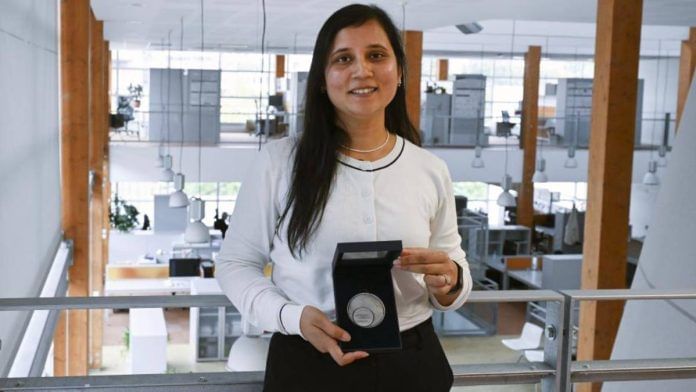Bengaluru: As a girl in her tweens, Kshama Sharma cherished a quote by physicist Marie Curie, the first woman to win a Nobel Prize—‘Nothing in life is to be feared, it is only to be understood. Now is the time to understand more, so that we may fear less’.
Years later, Sharma has been awarded the ‘L’Oréal-UNESCO For Women in Science Young Talent France 2025’ honour and Curie’s saying has come back to her as she remembers her younger self navigating challenging domains in science.
“I realised this is how I am as a person. I don’t go for easy options… I really like challenging things, so I chose the field of solid state nuclear magnetic resonance,” she said, speaking to ThePrint over phone from France, narrating her journey from Ghaziabad to Université Claude Bernard where she is a postdoctoral fellow at the Very High Field Nuclear Magnetic Resonance Center in Lyon.
Nuclear magnetic resonance (NMR) is a technique that uses a strong magnetic field and radio waves to analyse the structure of molecules. In France, Sharma’s work revolves around NMR and usage of Dynamic Nuclear Polarisation (DNP) technique to understand how specific virus particles interact with vaccines, with the data to be used for the betterment of vaccines.
On 8 October, Kshama Sharma was among 34 awardees whose work got recognised as impactful to the field of science, inspiring young girls to pursue the discipline at a time when only 33% of researchers in the world are women, according to UNESCO data.
She was selected from around 700 applicants by a jury of more than 30 members of the French Academy of Sciences. The award consists of grant money of 20,000 euros.
“I would like to use (the grant) for interacting with larger audiences,” said Sharma, who is looking forward to attending a conference in South India, NMR meets Biology, early next year. The conference, organised by Tata Institute of Fundamental Research (TIFR), will focus on tackling challenges in biology through non-traditional magnetic resonance techniques.
Before she took up her big projects, Sharma was a girl who built her success on hard work and timely opportunities.
Also Read: How 3 scientists who won physics Nobel brought ‘quantum physics from subatomic world onto chip’
From tutor to researcher
Sharma thanked her high school teachers back in Ghaziabad for getting her interested in physics and chemistry. And when she decided to apply for graduate studies, it was either physics or chemistry that was her obvious choice, she told ThePrint.
Destiny placed her at Hansraj College, University of Delhi. Each morning, she said, she would wake up early and spend two hours taking chemistry tuitions for neighbourhood kids and spend an hour again in the evening doing the same.
This way she kept her basics in chemistry intact and the work helped her pocket as well.
“While teaching, they ask you questions. I had really good students who were questioning my intelligence. (At times), I used to say that I don’t know this, and then discuss it with my friends in college,” Sharma said.
After completing graduation, she got selected at TIFR in Mumbai for an integrated Ph.D. course where she got interested in NMR, a subject which would subsequently take her beyond borders.
“My supervisor, P.K. Madhu, was teaching this course of solid state nuclear magnetic resonance. I chose it because it was really hard for me. I wanted to learn all those equations and mathematics because this was not my background, so I learned how to speed up the data acquisition process,” Sharma explained.
NMR is almost like an MRI scan for materials. It goes into the details of atoms and understands how they behave in the presence of a strong magnetic field. From this behaviour, a larger picture of the structure of a material can be understood.
The NMR process usually takes months, and Sharma was involved in reducing the time from months to weeks. Meanwhile, she said, she also applied her skills in projects involving Alzheimer’s disease and solar cells.
“If you understand the lock, you can design a key for it. (Similarly) if you know the structure of a protein, you can design a key or drug molecule for it,” Sharma said.
Fundamentally, her task was to figure out the structural interaction between two substances, be it amino acids in the brain (in Alzheimer’s) or Perovskite solar cells.
“You can get molecular level information which is a bit difficult to get from other analytical techniques. This is what I think (is) the beauty or the power of this technique,” said Sharma.
Virus-vaccine relationship
Sharma is not a fan of strict boundaries between scientific disciplines. She said she upskilled her NMR knowledge to help in vaccine development.
The area is a mix and match of physics, chemistry and life sciences and Sharma uses DNP technique which increases the sensitivity of NMR for better measurement.
Using DNP, the sensitivity of electrons to a magnetic field can be transferred into the nucleus of the atom, so that the nucleons become susceptible to magnetic field and respond to it with greater sensitivity. According to Sharma, in India no one uses DNP for research.
She looks at how nano particles in vaccines adsorb on inactivated virus particles along the surface to understand the interaction between inactive virus and vaccine.
“Obviously, it has been studied a lot but the molecular-level picture of this interface between the adjuvant (vaccine) and the antigen is not possible with other techniques, so we use DNP,” Sharma said.
Her hopes are high. She expects the result to help in design of better vaccines.
But her larger vision is to inspire and rope in young girls to break the glass ceiling in science.
(Edited by Nida Fatima Siddiqui)






